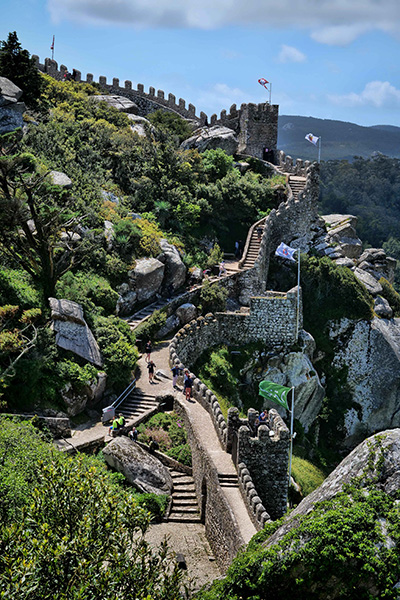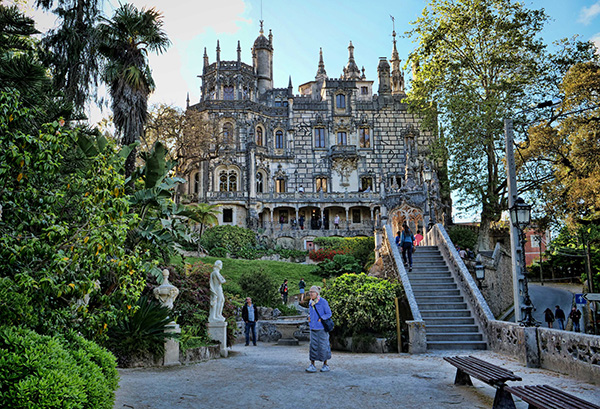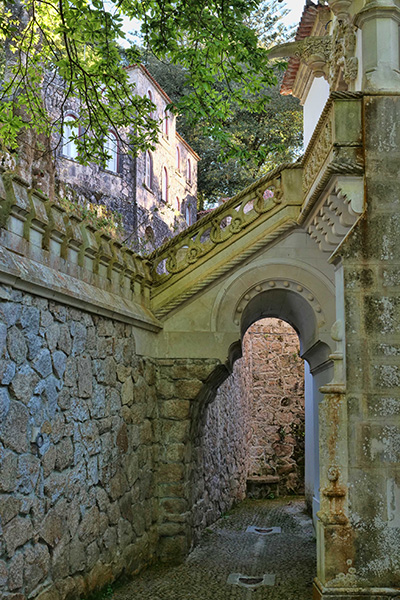Sintra, Portugal – Guest Post Part Two
by Ken MacAdams
Ken shares his travel photography and stories here on Successful-Photographer as he has in the past. Ken’s camera of choice is Panasonic’s flagship stills camera the Lumix G9 with the Leica DG Vario-ELMARIT Professional Lens, 12-60MM, F2.8-4.0
Take it away Ken. Start with part one of this story here.
A five minute walk downhill brought me to my second stop, the Moorish Castle. The castle was constructed during the 8th and 9th centuries, during the period of Muslim Iberia. The castle was centrally located in an area that was primarily agricultural, and was necessary for protection of the residents. It was a strategic point during the Reconquista, but was taken by Christian forces after the fall of Lisbon in 1147. Settlers occupied the castle during the 12th and 13th centuries, but its military importance was progressively diminishing, and inhabitants were abandoning the castle for the old village of Sintra. In the beginning of the 15th century a small group of Jews occupied the castle until being expelled from the country by Manuel I of Portugal.

Inside the Moorish Castle. These walls match the terrains ups and downs with lots of archery vantage points. In ancient days, they would have cleared the trees around the outside of the compound so attackers had no shelter. Images in this post © Ken MacAdams
The 1755 Lisbon earthquake caused considerable damage to the chapel and castle. It wasn’t until King Ferdinand II began work on the Pena Palace around 1840, that he took up the task of improving the condition of the old Moorish Castle and walls. The castle is built on very rugged terrain with slopes reaching 40% gradients. The hike around the castle walls is bound to elevate your pulse! A stop at each watchtower allows you to catch your breath and enjoy the magnificent views.

Secluded archway leading to the palace. Examine the rope detail on the sides of the stairs.
Having navigated the castle walls, I retraced my steps – also uphill – to where I’d parked the car. Returning to back to Sintra, I visited the Quinta da Regaleria. This highly decorated, ornate Gothic styled, multi-story 20th century residence is situated in Old Town. The original house dates back to the 1800’s. Over the years, subsequent owners have made renovation, the most recent being about 1904, when carved gargoyles, Gothic turrets, exotic woodwork and other ornate features were added. Additions by an Italian architect evoked Roman, Gothic, Renaissance, and Manueline styles. Located within the park is the palace and chapel, and a luxurious park with walkways, lakes, grottoes, wells, benches, statues, and fountains.

The Quinta da Regaleria palace and stature gardens.
The true wonder of the Quinta da Regaleria are the grounds, which were inspired by the owner’s mystic ideologies. Hidden within the grounds are references to the Knights Templar, the Masons, and dark alchemy. The well, one of the strangest features, has a concealed circular passageway that descends 88 ft. downward, then connects to a series of tunnels that run the length of the garden. The well symbolizes the initiation ceremony for the Knights Templar. As you walk through the gardens, you’re also awarded occasional glimpses of the Moorish Castle and Pena Palace high up on the mountain above you.
I’d packed all three sights into one day, so my feet were happy to settle into a comfy booth at one of downtown Sintra’s cafes! Shortly thereafter, I returned to the villa, and enjoyed a quiet nights’ sleep.
Ken has always loved to travel, so when he made a common connection with the fact that either a long day pounding the streets of some foreign city, or shooting the last dance at a wedding, a good part of his physical

weariness came from lugging around his big heavy DSLR. That’s when he started looking at alternatives – and ended up selecting Panasonic Lumix Micro Four Thirds gear.
Ken is rarely without a camera, and the next great photo travel experience – whether local or abroad – is always in the back of his mind! A longtime resident of the Four Corners, and when he’s not out on the road, he enjoys some of the great outdoor opportunities found there – mountain biking, hiking, and Jeeping.
 Inside the Moorish Castle. These walls match the terrains ups and downs with lots of archery vantage points. In ancient days, they would have cleared the trees around the outside of the compound so attackers had no shelter. Images in this post © Ken MacAdams
Inside the Moorish Castle. These walls match the terrains ups and downs with lots of archery vantage points. In ancient days, they would have cleared the trees around the outside of the compound so attackers had no shelter. Images in this post © Ken MacAdams weariness came from lugging around his big heavy DSLR. That’s when he started looking at alternatives – and ended up selecting Panasonic Lumix Micro Four Thirds gear.
weariness came from lugging around his big heavy DSLR. That’s when he started looking at alternatives – and ended up selecting Panasonic Lumix Micro Four Thirds gear.






